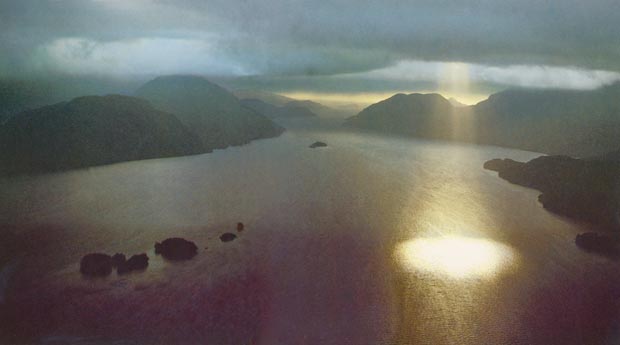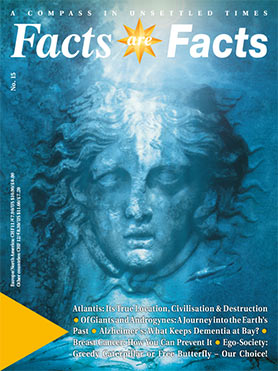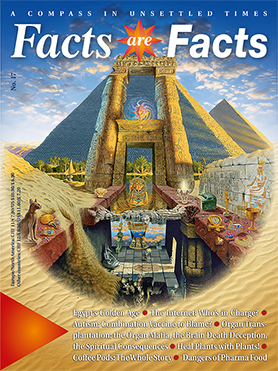Lemuria – The Lost Continent
Long before Atlantis rose from the waves, mankind dwelt on Lemuria. It was a golden age in the ‘Garden of Eden’ – but then came the ‘Fall’. Giant creatures roamed through forests of gigantic ferns, seeking shelter from the raging elements – until one day their world sank into the ocean, leaving barely a physical trace.
If you were to take a closer look at the scattered islands of the Pacific Ocean, you might notice a few peculiarities. How is it possible that the inhabitants of these islands all have the same ethnic origin, and speak almost identical languages, when they are divided by thousands of miles of ocean, and when for centuries their only form of transport was the dugout canoe? Why do the Malaccan islanders recount the same legends as the Fijians and the inhabitants of far-flung Easter Island, way off in the eastern Pacific?

Sunlight at play: A heavenly greeting at Dusky Sound, New Zealand. Lemuria, of which New Zealand once formed part, may well have looked like this.
These questions can be answered by looking at the nature of these peoples’ legends. In the north and south, east and west of the Pacific, they all tell the same tale: there once existed a great land, a continent that sank into the sea a long, long time ago. The highest mountain peaks of this lost continent still poke above the water. They form the many small islands on which the people saved themselves at the hour of disaster, as their homeland Lemuria disappeared beneath the waves.
The legend was current in India as well. In the 19th Century, a French writer by the name of Jacolliot came across an old legend, according to which a giant continent had existed in the Indian and Pacific Oceans several hundreds of thousands of years previously, before being destroyed when geological layers broke asunder. What remained were the islands of Madagascar, Sri Lanka, Sumatra, Java, Borneo, and the Pacific islands (Australia and New Zealand also belonged to the lost land). Easter Islanders tell their children a very similar story. Their land was once much, much bigger, but it was sunk into the sea by Uoke because of the sins of its inhabitants.
Not only legends, but the Earth itself testifies to the prior existence of a continent in the Pacific. In 1946, members of the Byrd expedition1 claimed to have discovered remains from Atlantis in the middle of the Pacific Ocean. West of South America, they had found an underwater platform that was clearly of human origin. With Atlantis being a lot better known among non-specialists than Lemuria (also known as ‘Mu’), of which the members of the Byrd expedition obviously were not aware, they believed they had found Atlantean remains. The fact is that they had found an artificial structure – which couldn’t possibly have had a natural origin – in the area once occupied by Lemuria.
Some years later, in 1965/66, a scientific expedition set out along the Peruvian coast aboard the Anton Brunn research ship. Robert J. Menzie, head of the oceanography department at Duke University, was, along with other specialists, making images of the ocean floor. Fifty miles west of Callao, above the 2,000m deep Milne-Edwards Trench, they took a whole series of underwater photographs showing the remains of a sunken city. Stone statues covered with hieroglyphs can be quite clearly made out amidst the mud of the ocean floor. Newspaper reports also indicated that sonar soundings had picked out hills that were identified as more ruins.
It’s not just at sea that remains of the sunken continent have been found. On November 8th 1938, a news bulletin in New York announced the astonishing discovery of a 40 ton monolith. Unearthed during a two-year expedition by the Fahrestack brothers to the Fijian island of Vanua Levu, the monolith was engraved with an unknown script. This ‘archaeological puzzle’ remains unexplained.
Still, the most famous and most puzzling witnesses to an unknown, ancient culture are undoubtedly the gigantic statues of Easter Island. “We could hardly conceive how these islanders, wholly unacquainted with any mechanical power, could raise such stupendous figures, and afterwards place the large cylindric stones upon their heads”, noted Captain Cook in his journal, after reaching the isolated island in March 1774. There are more than 250 of these giant, mysterious heads in total, scattered across the island or lying in the crater of the extinct volcano where they were carved. Over the last few years, the islanders have attempted to raise some of the fallen stone giants. Their modern cranes have only been able to cope with the smaller ones: the medium-sized and larger ones are too much for them.
“Some of the statues are only a few metres tall, others reach up to 20 metres”, remarked Easter Island expert Fritz Felbermayer. How could a prehistoric people have managed to align them in such orderly rows? These are the same questions that we ask ourselves when we marvel at monuments like Stonehenge, or the innumerable, meticulously ordered menhirs of Carnac.
“The list of archaeological evidence for the existence of a continent in the Pacific is practically endless. Moreover, it’s as good as certain that what has been discovered up to now is nothing compared to what still awaits the archaeologists in the ground and in the sea. How can we doubt the historical reality of Mu, this aboriginal home of mankind, the cradle of a fantastical, worldwide civilisation, of which, in a sense, we are all heirs?” asks Jean Prachan in his book The Secret of Easter Island (only available in German).
The Earth is No Stranger to Cataclysms
A legendary memory of a devastating ‘world flood’ is part of humanity’s common inheritance, as was mentioned in the article about Atlantis. Richard Hennig totted up the world’s flood legends for his book Wo lag das Paradies? (‘Where Was Paradise?’; not available in English): “Asia can count 13 independent flood legends, Europe four, Africa five, Australia and the South Sea islands nine. The Americas combined count a full 37, North America having 16, Central America seven, and South America 14”. In some mythologies, above all in Irish mythology, the ‘great flood’ marks the transition from prehistory to history, with all previous races being killed off. “In reality, not all races were destroyed; only the race referred to by the Easter Islanders as the ‘primordial race’ – the inhabitants of Mu, who were obviously overwhelmed by the sudden rise in water levels. Their continent drowned”, writes Jean Prachan, and adds: “But when and how did this take place?”
Academia’s attempts to answer this question remain wide of the mark. Their bald answer is that it took place in the 7th or 8th millennium BC… at a time when Atlantean Poseidonis had been underwater for over a thousand years. Around 1.5 million years separate its downfall from that of the continent of Mu!
One hundred years ago, an American newspaper printed a sensational article attempting to answer the ‘how’ question. Dr Paul Schliemann, grandson of the famous discoverer of Troy, had been travelling the globe for many years in search of sunken lands, reported the New York American on October 20th 1912. In a Buddhist temple, in the then still-closed city of Lhasa in Tibet, he found an intriguing Chaldean text.
“When the star Bal fell on the place where is now only sea and sky the Seven Cities with their Golden Gates and Transparent Temples quivered and shook like the leaves of a tree in storm. And behold a flood of fire and smoke arose from the palaces. Agony and cries of the multitude filled the air. They sought refuge in their temples and citadels. And the wise Mu, the hieratic of Ra-Mu, arose and said to them: ‘Did not I predict all this?’ And the women and the men in their precious stones and shining garments lamented: ‘Mu, save us.’ And Mu replied: ‘You shall die together with your slaves and your riches and from your ashes will arise new nations. If they forget they are superior, not because of what they put on, but of what they put out, the same lot will befall them!’”
In 1973, the Brazilian linguist Vaz de Melo claimed to have deciphered Easter Island’s hieroglyph-covered rongorongo tablets. What he found included stories of panicking people trying in vain to flee as a giant fireball hurtled towards the furthest tip of the ‘archipelago’ where the ancestors of the Easter Islanders had lived.
We need to get used to the rather disturbing fact that it is quite normal for Mother Earth to let continents sink, and raise them again, and that the history of the Earth is a history of cataclysms and magnetic field reversals. As the ‘Mahatma’ or Master Kuthumi (in the old style, Koot Hoomi, or K.H.) put it to A. P. Sinnett in 1882: “No doubt your geologists are very learned; but why not bear in mind that, under the continents explored and fathomed by them, in the bowels of which they have found the ‘Eocene Age’ and forced it to deliver them its secrets, there may be, hidden deep in the fathomless, or rather unfathomed ocean beds, other, and far older continents whose stratums have never been geologically explored; and that they may some day upset entirely their present theories, thus illustrating the simplicity and sublimity of truth as connected with inductive ‘generalization’ in opposition to their visionary conjectures. Why not admit – true, no one of them has ever thought of it – that our present continents, have – like ‘Lemuria’ and ‘Atlantis’ – been several times already, submerged and had the time to reappear again, and bear their new groups of mankind and civilisation; and that, at the first great geological upheaval, at the next cataclysm – in the series of periodical cataclysms that occur from the beginning to the end of every Round, – our already autopsized continents will go down, and the Lemurias and Atlantises come up again.” So, according to the Mahatma, our ‘new’ America was formed as the old Atlantis sank and was gradually washed away.
The next lands to meet their end through fire (underwater volcanoes), and water, will be the British Isles. “France and other lands will follow suit.” There’s a good chance that another few thousand years, or even tens of thousands, will pass before this happens, so there’s no need to evacuate Britain today. In the very distant future, these lands will reappear. As Kuthumi put it, “When they reappear again, the last seventh Sub-race of the sixth Root race of present mankind [cf. the corresponding article, page 35] will be flourishing on ‘Lemuria’ and ‘Atlantis’ both of which will have reappeared also (their reappearance following immediately the disappearance of the present isles and continents), and very few seas and great waters will be found then on our globe, waters as well as land appearing and disappearing and shifting periodically and each in turn.” Blavatsky, in her Secret Doctrine, which was inspired by adepts, reveals that the Earth has been shattered by cataclysms four times since the emergence of the first race.
The most ancient Sanskrit and Tamil works too are full of references to sunken continents. The Puranas tell us that there was once a continent in today’s Arctic, stretching from Spitsbergen to the English Channel, and where magnolias bloomed. Greenland is a remnant of this polar continent. In contrast, in the late Lemurian Age, as Lemuria fragmented, neither Africa, America, nor Europe existed as we know them today: they all slumbered on the bottom of the sea. Only the southern areas of Asia, along with east and west Siberia, existed at that point.
Sources
- 1 Rear Admiral Richard Evelyn Byrd was a famous US American naval officer and polar explorer who was in charge of "Operation Highjump", the largest Antartic expedition ever.






